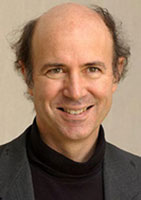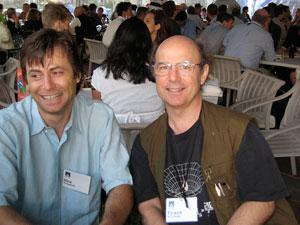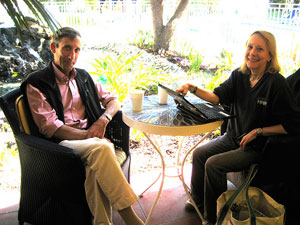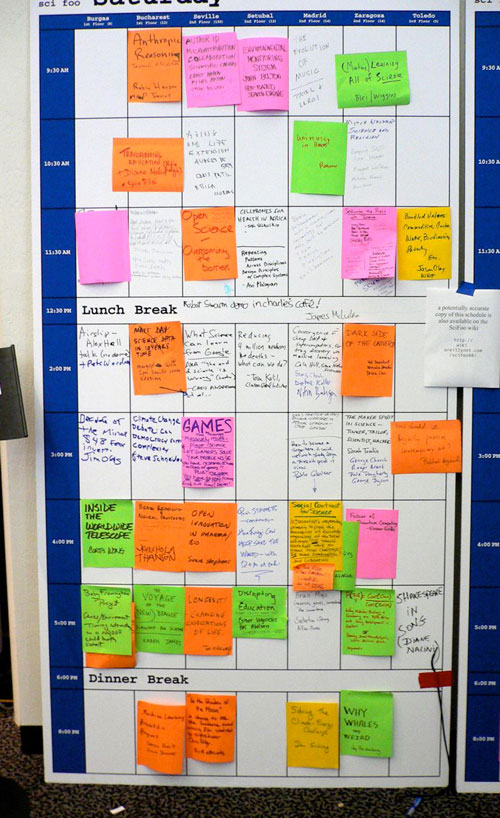A SLICE OF SCIFOO
SciFoo is a conference like no other. It brings together a mad mix from the worlds of science, technology, and other branches of the ineffable Third Culture at the Google campus in Mountain View. Improvised, loose, massively parallel—it's a happening. If you're not overwhelmed by the rush of ideas then you're not paying attention.
George Dyson's marvelous Edge post from last year gives a lively sense of SciFoo "organization" and atmospherics.
I tried to maintain a state of controlled bewilderment, letting the experience wash over me. Now, three weeks later, a few big impressions and ideas have crystallized out. Here they come:
1. Three-Word Autobiography
SciFoo begins with a round of stylized introductions. Since 200 or so people are involved, brevity is a primary virtue. The stated mandate is: name, affiliation, three word self-presentation. Most people interpreted "word" very liberally, in the spirit of the days of Genesis, to encompass "phrase" or "topic". I was among the happy few who literally presented themselves in three words, sat down and shut up. In the process, I discovered both a philosophy of life, an algorithm for creativity, and the title of my fictitious autobiography:
Think, Play, Repeat
Afterwards, Max Tegmark remarked that this actually packs in an infinity of words!
2. Engines of Information
I've long been fascinated by the possibility of emergent (artificial) intelligence, or rather super-intelligence. While we're not quite there yet, at Scifoo it was hard to escape the feeling that a true world-mind is nascent.
Computer scientists David Blei and Chris Wiggins advertised a session entitled "teaching a computer all of science". The title turned out to be a little joke; what they've done is fed a big chunk of the journal Science into a computer, and run sophisticated artificial intelligence programs on that material, to find correlations among the words.
A sort of meaning emerges spontaneously, as clusters of words that commonly occur together indicate the existence of an underlying, unifying concept. You can—and this may be the most fascinating result so far—follow the evolution of concepts over time, as specific words enter and leave the defining clouds. (So for example the old vacuum tube technology evolves before your eyes into modern microelectronics.)
At this level, what they've got is a useful tool for scientists and historians. As yet the machines don't actively seek sophisticated connections among the concepts they've discovered—in short, they don't think for themselves. But just having concepts seems a big achievement, as when a baby starts to refer to things in the world with appropriate words, if not sentences.
Game developer Jane McGonical gave a brilliant presentation on the potential of the game-playing world for science, and vice versa. She points out that Wikipedia was created in approximately 108 person-hours, which is equivalent to 5 days of World of Warcraft gaming (or 1 season of American Idol voting). She says that gamers are a resource available for creative use at any task that can be reformulated as play (which covers a lot of ground!).
Astronomers have led the way in citizen science, as in the recent Galaxy Zoo project and the classic SETI@home, but McGonical envisions much more. She also wants scientists to solve society's big problems by gaming out future world-scenarios at superstructgame.org. Looks like heavy fun.
For anyone who wants to try their hand at building organs for the world-mind, there's now an excellent, ground-up practical introduction to the toolset: Programming Collective Intelligence by Toby Segaran. I'm getting seduced, myself.
3. The Age of Ageing
There seems to be consensus, among age researchers, that understanding and controlling the ageing process is the problem of applied biology. They would think that, of course (especially if they're of a certain age ... ), but there's a strong objective case for it. As Aubrey de Grey and Tom Kirkwood both emphasized, curing any discrete disease (even such a big one as cancer) will make only a modest contribution to extending life expectancy (two to three years). Senescence—the general deterioration of vitality and resistance to adversity with advancing age—is the real culprit. Why does it occur? What are the prospects for slowing it?
There is a plausible evolutionary explanation, emphasized by Kirkwood. In the wild, animals do not get old—they fall victim to predators, parasites, or nasty accidents prior to senescence. Evolution favors getting in as much reproduction as possible, so it favors maximizing vitality and reproductive power during the lifespan as naturally limited by predators, parasites, and accidents. Repairs or investment in reserves that would pay off later than that are never undertaken, and senescence is the consequence.
If that's right—and there's considerable evidence that in essence it is—then senescence is likely to be a multifaceted complex of problems. But modern biology is powerful, and both Kirkwood and de Grey—though their short-term expectations are wildly different—argue that the time is ripe for a serious assault on those problems. For their respective takes, see Kirkwood and The End of Aging (de Grey and Rae). Given the profound importance of the problem, and the amount spent on what after all amount to relative stopgaps (e.g., curing cancer!), it's hard to resist the argument that much more money and effort should be going into ageing research.
(An interesting specific: One way to defer senescence is well established for many animals, ranging from yeast and simple worms to mice. It is semi-starvation, also known as caloric restriction. It can make really big changes in life expectancy—a factor of two is not unheard of. Kirkwood, however, is not optimistic that it will work for humans. What seems to happen, in response to caloric restriction, is that the organism switches to a state where less metabolic energy is invested in reproduction, and more in repair. That makes evolutionary sense: in hard times, you hunker down and wait for conditions to improve, both for yourself and for your potential offspring. Normally reproductive activity is a heavy burden on mouse metabolism, so relieving it can free up significant resources. For humans, however, the burden is light.
So go ahead and eat.)
4. Planet Mushroom
Paul Stamets is—quoting Michael Pollan—"a visionary emissary from the fungus kingdom to our world". He sees mushrooms as a replacement for chemical pesticides, a natural filter of toxins, and underground network ("nature's Internet") over which information flows—a primitive world-brain with vast growth potential. He also markets caps made from them. We took home a copy of his fascinating, lavish book Mycelium Running: How Mushrooms Can Help Save the World, which I've been enjoying immensely. (If you've ever had trouble with carpenter ants, you'll savor the Schadenfreude of Chapter 8.) For a free taste of Stamets, check out http://www.youtube.com/watch?v=BelfLIJErek.
5. Space Rocks
Former astronaut Ed Lu, now a Google employee, gave a superb talk about earth-impacting asteroids. One killed off the dinosaurs, and another could have our number. Besides the rare ultra-catastrophic collision, there are much more frequent collisions that deliver punches comparable to or larger than nuclear weapons—famous ones produced Meteor Crater Arizona about 50,000 years ago and the Tunguska event in 1908. Today people are gearing up to census the potentially dangerous objects, and thinking seriously about how to divert them. Small asteroids are irregular, loosely bound clouds of rubble, not solid rocks, which complicates matters considerably. You can learn more, and perhaps choose to advance the cause, by following links from http://en.wikipedia.org/wiki/B612 Foundation.
Besides that talk about space rocks, there was a screening of In the Shadow of the Moon—a 2007 documentary about how space rocks, or rather about how the U. S. space program rocked in the 60s and 70s (hosted by David Sington, the director). It features original footage, together with interviews of the surviving Apollo astronauts. The movie is affecting on many levels: as the story of a triumphal adventure, as a portrait of unlikely young heros in their later years, as a memorial of an America familiar and yet startlingly different. I laughed, I cried, I thought. In the Shadow of the Moon is now available as a DVD, and highly recommended.
6. LHC, the Universe, and All That
I organized this hour. Brian Cox, a charismatic experimenter in high energy physics who is also a well-known BBC presenter, described the Large Hadron Collider (LHC) itself. It's our civilization's answer to the Pyramids of Egypt. But better: it's a monument to curiosity, not superstition, and it's grand scale reflects the greatness of the questions it addresses, not the vanity of its overseers. Then I discussed the issues at stake—cosmic superconductivity, unified field theory, supersymmetry— directions in which our present laws of physics beg to be improved and unified. The LHC will (finally!) give decisive verdicts about those ideas.
Turning from the very small to the very large, Max Tegmark gave us a visual tour of the Universe using http://qso.lanl.gov/pictures/Pictures.html. The Universe is pretty big, but fortunately the speed of thought is faster than the speed of light, so we got around pretty well! Martin Rees capped it off by explaining why many of us believe that the known Universe may be only a speck within a much larger Multiverse.
Our understanding of these (superficially) vastly different domains—absurdly small and ridiculously large; concrete and experimental, theoretical and speculative—is, amazingly, all of a piece. The basic laws studied at LHC tell us how the Big Bang worked. And together they encode the emerging multiverse that emerges, including its mysterious dark matter and dark energy. We've made dramatic progress, and the best is yet to come: it's an exciting time to be a physicist.








